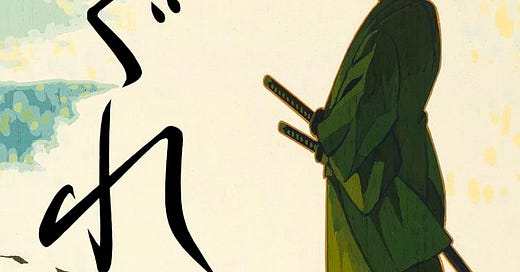I was pleased to recently review the historical samurai novel Semishigure, by Shuhei Fujisawa, over at the Asian Review of Books. As the review outlines, this sort of novel is one that rarely makes it into English despite being very popular in Japan. With the exception of an abridged translation of Eiji Yoshikawa’s Musashi, there aren’t a lot of historical samurai novels translated for anglophone audiences (though, happily, Musashi is slated to be released in a new, unabridged translation soon).
My own love of samurai stories comes primarily from film, especially the works of Akira Kurosawa. My dad showed me several of his movies over the course of a weekend when I was in middle school, thus sparking not only a lifelong love of Kurosawa and Japanese film more broadly, but also an ongoing fascination with traditional Japanese culture and with samurai. I read both Yoshikawa’s Musashi and The Book of Five Rings, and later I was fascinated by Hagakure and the samurai ethos. This ethos was mad in many respects, and of course samurai were inextricably linked with violence, often toward the vulnerable, as seen in many films dealing with Japanese history. Kobayashi’s Harakiri, for instance, is one of the most damning critiques of samurai culture ever made and is one of my favorite samurai films despite (or because) it’s so anti-samurai. Mizoguchi’s Ugetsu is also worth mentioning in this respect, though it’s less concerned with samurai specifically.
I thus don’t see any reason to valorize the warrior ethos of those times (at least without heavy qualification), and modern attempts to do so, as with figures like Yukio Mishima and some of his more degenerate admirers in our own time, strike me as misguided. Nevertheless, I can’t help but be fascinated by samurai and the combination of brutality and artistry in figures like Musashi, whose talents included not only swordsmanship but also calligraphy, strategy, painting, and writing. He considered all of these paths interconnected, moreover, and took a positively artistic approach to the sword. He is famously said to have demanded that any potential opponent cut a flower and send it to him before he would agree to a duel. He would determine his adversary’s worthiness based on the quality of the cut stem. Whether or not this is true, it’s a story I find beautiful, and I have immense respect for the level of mastery, indeed of craftsmanship, that it indicates, despite the violence for which the sword was made.
I must also confess a fascination with elements of Hagakure’s warrior “mysticism,” if I may be allowed the phrase. The attempts, though grotesque, to see oneself as a corpse, as already dead, and to achieve this state of consciousness through constantly imagining one’s own violent end are not practices I could recommend, but I find such determination and self-transcendence inspiring. This may be the masochist in me, but, really, it’s hard to imagine anything more metal than constantly meditating on yourself falling off cliffs or being mauled by a bear until you become fearless. I’m not saying it’s right, but it is hardcore.
None of these considerations is ultimately that relevant to Semishigure, which paints a relatively benign picture of samurai life during a mostly peaceful era. Yet the book contains a great deal of swordsmanship and offers intriguing insights into day-to-day life in historical Japan. If nothing else, it’s exciting to see books like this being translated, and we can hope there are more to come.





